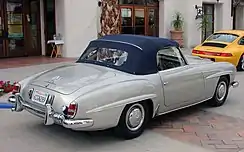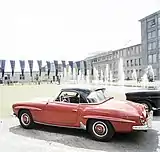Mercedes-Benz 190 SL
The Mercedes-Benz 190 SL (W121) is a two-door luxury roadster produced by Mercedes-Benz between May 1955 and February 1963. Internally referred to as W121 (BII or B2), it was first shown in prototype at the 1954 New York Auto Show, and was available with an optional removable hardtop.
| Mercedes-Benz 190 SL | |
|---|---|
.JPG.webp) | |
| Overview | |
| Manufacturer | Mercedes-Benz |
| Production | 1955–1963 25,881 built[1] |
| Assembly | West Germany: Stuttgart Untertürkheim |
| Body and chassis | |
| Class | Sports car / Grand tourer |
| Body style | roadster |
| Layout | FR layout |
| Platform | Mercedes-Benz W121 |
| Related | Mercedes-Benz W198 (300 SL) Mercedes-Benz W120/121 |
| Powertrain | |
| Engine | 1,897 cc M121 SOHC I4 |
| Transmission | 4-speed manual, fully synchronized |
| Dimensions | |
| Wheelbase | 2,400 mm (94.5 in) |
| Length | 4,390 mm (172.8 in) |
| Width | 1,740 mm (68.5 in) |
| Height | 1,320 mm (52.0 in) |
| Curb weight | 2,552 lb (1,158 kg) |
| Chronology | |
| Successor | Mercedes-Benz W113 (230SL) |
- See Mercedes-Benz SL-Class for a complete overview of all SL-Class models.
The 190 SL presented an attractive, more affordable alternative to the exclusive Mercedes-Benz 300 SL, sharing its basic styling, engineering, detailing, and fully independent suspension. Both cars had double wishbones in front and swing axles at the rear. Instead of the 300 SL's expensive purpose-built W198 tubular spaceframe, the 190 SL's R121 structure used a shortened unitary floorpan modified from the W121 base saloon.[2]
The 190 SL was powered by a new, slightly oversquare 105 PS (77 kW; 104 hp) Type M121 BII 1.9 L straight-four SOHC engine. Based on the 300 SL's straight six,[3] it had an unchanged 85 mm bore and 4.3 mm reduced 83.6 mm stroke, was fitted with twin-choke dual Solex carburetors, and produced gross 120 hp (89 kW; 122 PS).[3] In detuned form, it was later used in the W120 180 and W121 190 models.
The car was available either as a soft-top convertible (initially priced at DM 16,500/US$ 3,998[4]) or with removable hardtop (DM 17,650/$ 4,295). A small third-passenger transverse seat was optional. During its first years the 190 SL was available as a sports-racing model with small perspex windscreen and spartan one-piece leather covered bucket seats and aluminium doors. In 1959, the hardtop's rear window was enlarged.
In 1956, a few six-cylinder prototypes were built for testing. A 190SL with a unique engine, using the 300SL block, squeezed into the engine bay with a one-off mix of Benz-bin parts was entered in the 1956 Alpine Rally, but the costs of production would be prohibitive. Two other prototypes, fitted with fuel injected M180 220SE engines were baptised the W127 / 220SL. In June 1956, Rudi Uhlenhaut and Karl Kling lapped the Nürburgring Nordschleife circuit in the two W127s a good 25 seconds faster than a regular 190SL.[5] On 12 April 1957, MB's board decided to build the W127, six-cylinder 220SL alongside the 190SL, but production challenges postponed manufacturing until it was overtaken by the 230SL 'Pagoda'.[6]
Both the 190 SL and the 300 SL were replaced by the Mercedes-Benz 230SL in 1963.
Super-Leicht or Sport-Leicht
Mercedes-Benz did not announce what the abbreviation "SL" meant when the car was introduced.
Leicht means either "easy" as an adverb or "light" as an adjective in German. Defining a car it has to mean "Light".
It is often assumed that the letters stand for Sport Leicht. One car magazine in 2012 declared that the abbreviation "SL" - "securitized and personally signed by Rudolf Uhlenhaut" meant Super Leicht.[7] This contradicts "Mercedes-Benz 300 SL" of Engelen / Riedner / Seufert, which was produced in close cooperation with Rudolf Uhlenhaut showing that the abbreviation meant Sport Leicht.[8]
Mercedes-Benz used both forms until 2017. It was even called Super Super.[9] On the company website it was called Sport Leicht until 2017 and than changed to Super Leicht.[10]
For a long time it was unclear what intention the company had at the time when assigning the letter combination. It was not until the beginning of 2017 that a chance finding in the corporate archive, from the early part of 1952, clarified that at least in the case of the 300 SL the abbreviation SL stood for Super-Leicht.[11]
Technical data
| Mercedes-Benz | 190 SL |
|---|---|
| Produced: | 1955–1963 |
| Engine: | 4-cylinder-inline engine (four-stroke), front-mounted |
| Bore x Stroke: | 85 mm x 83.6 mm |
| Displacement: | 1897 cc |
| Max. Power @ rpm: | 105 PS (77 kW; 104 hp) @ 5700 |
| Max. Torque @ rpm: | 142 N⋅m (105 lb⋅ft) @ 3200 |
| Compression Ratio: | 8.5: 1, from 09/59 8.8:1 |
| Fuel feed: | twin two barrel sidedraft carburetors – Solex 44PHH |
| Fuel tank capacity: | 65 L (17.2 US gal; 14.3 imp gal) |
| Valvetrain: | SOHC, duplex chain |
| Cooling: | Water |
| Gearbox: | 4-speed manual, lever between seats rear-wheel drive, standard axle ratio 3.90:1 |
| Electrical system: | 12-volt |
| Front suspension: | Double wishbones, coil springs, stabilizing bar |
| Rear suspension:: | Swing axle, coil springs |
| Brakes: | Drum brakes (Ø 230 mm), power assisted |
| Steering: | Recirculating ball steering |
| Body structure: | Sheet steel, uni-body construction |
| Dry weight: | 1,160 kg (2,560 lb) (Hardtop: + 20 kg (44 lb)) |
| Loaded weight: | 1,400 kg (3,100 lb), from 1961 1,440 kg (3,170 lb) |
| Track front/ rear: | 1,430 mm (56.3 in) 1,475 mm (58.1 in) |
| Wheelbase: | 2,400 mm (94.5 in) |
| Length: | 4,290 mm (168.9 in) |
| Width: | 1,740 mm (68.5 in) |
| Height: | 1,320 mm (52.0 in) |
| Tyre/Tire sizes: | 6.40–13 Sport |
| Top speed: | 173 km/h (107 mph) |
| Fuel Consumption (estimate): | 12.5 litres per 100 kilometres (22.6 mpg‑imp; 18.8 mpg‑US) |
See also
| Wikimedia Commons has media related to Mercedes-Benz W121BII. |
References
- Oswald, Werner (2001). Deutsche Autos 1945–1990, Band 4. Stuttgart: Motorbuch Verlag. ISBN 978-3-613-02131-0.
- "RitzSite Mercedes-Benz 190 SL 1955–1963; page 2". Ritzsite.net. 2002. Archived from the original on 5 April 2006. Retrieved 9 June 2019.
- Smith, Maurice A., ed. (28 October 1966). "Used cars on test:1960 Mercedes-Benz 190SL Coupé". Autocar. 125. No. 3689. pp. 944–945.
- US prices: Mike Covello: Standard Catalog of Imported Cars 1946–2002. Krause Publication, Iola 2002, ISBN 0-87341-605-8, p. 528.
- 1950s Mercedes-Benz 190SL Development | HowStuffWorks
- Mercedes-Benz W127 | HowStuffWorks
- Jochen Übler (19 April 2012), "Trimm's Leicht", Auto, Motor und Sport, Mercedes SL-Spezial 2012 (in German) (10), pp. 14–17, ISSN 0005-0806
- Günter Engelen, Mike Riedner, Hans-Dieter Seufert (1999), Mercedes-Benz 300 SL (in German) (2 ed.), p. 31, ISBN 978-3-613-01268-4CS1 maint: multiple names: authors list (link)
- Gerold Lingnau (2002), "300SL – Die Ikone wird fünfzig", Mercedes-Benz Classic (in German) (1), pp. 10–22, ISSN 1610-8043
- media.dailercom; Motorsport als Zündfunke: Der Mercedes-Benz 300 SL Rennsportwagen der Baureihe W 194 (1952–1953), aufgerufen am 25. Juli 2017.
- Foto: Dokument des Namenvorschlags in: Die Zeit, 14. April 2017.

